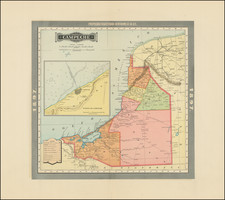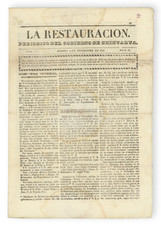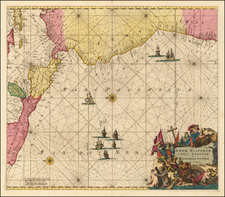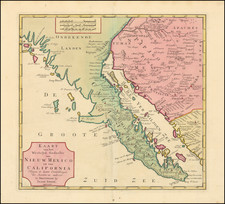19th Century Hand Drawn Copy of the Sigüenza Map
A circa 1830 hand-drawn pen and ink copy of the Sigüenza Map, a 16th-century Aztec document housed in Mexico City's Museo Nacional de Antropología. The map derives its name from its association with Carlos de Sigüenza y Góngora, a revered Mexican intellectual, who was among the first to study and value the depth of Aztec history and culture. It traces the Aztec migration from the 9th to the 13th century A.D. from Aztlan to the founding of Tenochtitlán, now Mexico City. This map is a vivid pictorial narrative that depicts the Aztecs' sacred migration journey to what is now central Mexico. It stands as a foundational visual icon of Aztec culture and society. Importantly, it portrays the historical and symbolic establishment of the city of Tenochtitlan, as well as its sister city, the marketplace altepetl of Tlaltelolco. The map is adorned with hieroglyphs, place glyphs, depictions of Indian principals, and pivotal historical scenes.
The present manuscript example was commissioned in the 1830s by Captain William Henry Shippard, an intriguing figure in early 19th-century Mexican studies and a friend of the painter George Catlin. Shippard avidly collected and studied early Mexican history for his various museum schemes that never got off the ground. Our manuscript may have been drawn by Agostino Aglio, who was known to have made copies of Mesoamerican manuscripts in the British Library for Lord Kingsborough, among others, in the first decades of the 19th-century. Indeed, Aglio is mentioned in Shippard's note, and also made copies of Mexican codices for William Bullock - the famous showman of Mexican antiquitities of Egyptian Hall fame who authored a book based on his travels in Mexico. And Aglio's name appears on Lord Kingsborough's important and elaborate illustrated work, The Antiquities of Mexico: comprising Fac-Similes of Ancient American Paintings and Hieroglyphics (1831-48).
The original Sigüenza Map, which has been a part of Mexico City's historical records since at least the 1600s and remains a treasured piece of the collection at the Museo Nacional de Antropología in Mexico City, is an artifact of profound historical significance: a 16th-century indigenous cartographic document that chronicles the epic journey of the Aztecs from Aztlan, their mythological homeland, to the establishment of Tenochtitlan, the heart of their future empire. This map captures not merely the geography but also the passage of time, encapsulating over four centuries of Aztec migration across the Mexican landscape. It is embellished with a lexicon of glyphs and images that denote key locations, events, and leaders, weaving a tapestry of the Aztec's mythic and historic odyssey.
This map gained broader exposure through the Neapolitan lawyer and traveler Giovanni Francesco Gemelli, who replicated it during his 1690s global journey. Gemelli's rendition was first published in his 1704 travelogue, A Voyage Round the World. Although Gemelli's credibility waned over time, his works, including unpublished maps, were later validated by Alexander von Humboldt in 1811 for their accurate depiction of Mexican geography.
Centered on what is now the historical core of Mexico City, the map is a window into the past, illustrating the Aztec migration through hieroglyphs and place glyphs. It depicts Indian principals and historical scenes, providing a glimpse into the confluence of native and European interpretations of history. This map is not just a geographical chart; it's a historical document that outlines the Aztec civilization's journey through time, highlighting their resilience, beliefs, and the pivotal moments that shaped their destiny.
Some of the toponyms herein, represented by numbered glyphs, can be identified through the excellent online resource, The Mapas Project, which is based on the the Gemelli version of the map. A selection of these toponyms, keyed to the handwritten numbers on our map, here follows:
1. Aztlan. Gyph showing an island with a tree and a bird, with a group of elite Aztec men standing and a single person lying prostrate in a boat. The bird's chirping is indicated by many swirls, like speech scrolls, but here emanating from the bird's beak.
5. A temple atop a stepped pyramid structure.
6. Huitzquilocan or Huitzquilucan, or the place of Thistle flowers.
7. Chicomoztoc, called by Gemelli, “seven grots" or Seven Caves.
8. Tetepanco, wall of many slopes.
9. Quauhtepec, mountain of the eagle, from quauhtli, eagle, and tepetl, hill or mountain.
13. Papantla.
14. Tzompanco, skull rack, from the root word for skull rack (tzompantli). Only one skull shown on the rack, impaled on a horizontal bar which rests on two upright posts.
18. Chalco, the place of the precious stone.
21. Azcaxochic, Flower of the Aris.
23. Tepetlapan, The Place of the Stone Call’d Tepetate.
25. Chapultepec, The Hill of Grasshoppers. The hill (tepetl) with the grasshopper (chapulin) on top.
28. Tlatelolco, the sister city to Tenochtitlan, with a large and important market and the site of a Franciscan college established soon after the Spanish occupation of the city.
34. Tenochtitlan, represented with a nopal cactus typically associated with Mexico, the capital city. Gemelli's depiction is notablly different, showing a crossroads with the cactu
Transcription of Text Written by William Henry Shippard in the Top Margin of the Map
Facsimile of a Mexican Hieroglyphic Painting or Picture writing embodying in one Picture the [missing text] tongues from a bird, their setting out under different leaders, their migration from the country they stopped at and the number of years they remained at each spot. Taken from the Giro[glyph?] having been refurnished and authenticated by A De Humboldtt in his Atlas Pittoresque and [Agostino] Aglio in h[is] [drawings?]
British [Library or Museum?] on, 9 August 183[4?]
Shippard, Catlin, Waldeck and Early Mesoamerican Collectors
While not much is known about William H. Shippard, we know he was a friend of George Catlin, and that he was involved in early London museum exhibitions of Mexican antiquities. In the latter efforts Shippard would seem to coincide with the small group of prominent English collectors interested in Mexican topics active during the 1820s and 1830s, including Lord Kingsborough and the bibliomaniac Sir Thomas Phillipps, among others.
While our map bears a close resemblance to the Gemelli version, we believe ours could be from a drawing by Frédéric de Waldeck, a noted archeologist/artist and pioneer of mesoamerican studies. Waldeck may have used Gemelli and Humboldt as a source, but his version was not a verbatim copy from either of those predecessors. Though the numbering of the glyphs on our map seems to correspond to that on plate 32 of Humboldt's 1811 Atlas Pittoresque, the orientation of the map is quite different.
Frédéric de Waldeck, who likely made the source drawing of our map between 1829-1831, was a prominent but somewhat controversial figure who published important early lithographic works concerning Mexican antiquities.
Waldeck, who may have drawn the original from which our map was copied, was also part of this melieu. Indeed, there exists documentary evidence that Catlin visited Waldeck, perhaps at the behest of Shippard, to view drawings of Aztec codices, likely with the idea of acquiring copies. While the exact date of Catlin's visit to Waldeck is not known, we know Catlin made his first trip to England in 1839. Consequently the present manuscript, which dates from ca. 1834, when Shippard was actively copying such material from the British Library and perhaps from private collections, was not part of Catlin's collections. Our manuscript sheds some light on Shippard's activities in early 19th-century mesoamerican collecting, a story that has not been fully revealed.
William Henry Shippard's Mexican Paintings
William H. Shippard (1803-1865) was a pioneering 19th-century British museologist - an unsung progenitor of modern-day museum anthropology. While he is chiefly remembered as a friend of George Catlin, Shippard's profound interest in the ancient civilizations of Mexico connects him with a cohort of British contemporaries that include Lord Kingsborough and the showman William Bullock. Shippard's fascination with Mesoamerica propelled him to amass a significant collection of visual material derived from Aztec codices which he copied himself. A figure of some intrigue and scholarly ambition, Shippard endeavored to establish the Museum of Mankind in London, which seems to have evolved from his deep interest in early Mexican cultures. Although the museum did not come to fruition, Shippard's original artwork, mainly pen and ink drawings enriched with vibrant hand coloring, based on Mexican codices held in European libraries and collections, remains a valuable historical source, particularly for understanding the allure of Mexican antiquity within early 19th-century British collecting circles.
Capt. William H. Shippard, a friend of George Catlin and an avid watercolorist and museologist, was also a pioneering British Mesoamericanist. Shippard appears in British newspaper notices from the 1840s as a London-based lecturer who spoke about Native Americans and Mexican antiquities. We know he was a friend of George Catlin, and that he was involved in attempts to organize early London museum exhibitions of Mexican antiquities. In the latter efforts Shippard would seem to coincide with a group of like minded prominent English collectors interested in Mexican topics active during the 1820s and 1830s, including Lord Kingsborough and the bibliomaniac Sir Thomas Phillipps, among others. He seems to have been an armchair anthropologist and would-be museum founder, whose ambitious ideas for a London-based museum never got off the ground - at least not beyond the prospectus-printing stage. Certain aspects of Shippard's career are akin to William Bullock, the showman and connoisseur of Mexican antiquities who actually did travel to Mexico. Bullock published a notable book about his Mexican travels, and achieved a level of recognition in his day as the empresario of London's Egyptian Hall, wherein he thrilled large London audiences with his elaborate exhibitions of exotica, including Mexican items.










![[Hand Drawn Map] Le Golfe de Mexique avec les Pays Circonvoisins](https://storage.googleapis.com/raremaps/img/small/91580.jpg)
![(Earliest Obtainable Map of San Diego Bay) Plan du Port De St. Diego en Californie. . . 1782 [with] Plan Du Port et du Departement de San Blas . . . 1777](https://storage.googleapis.com/raremaps/img/small/61850.jpg)


